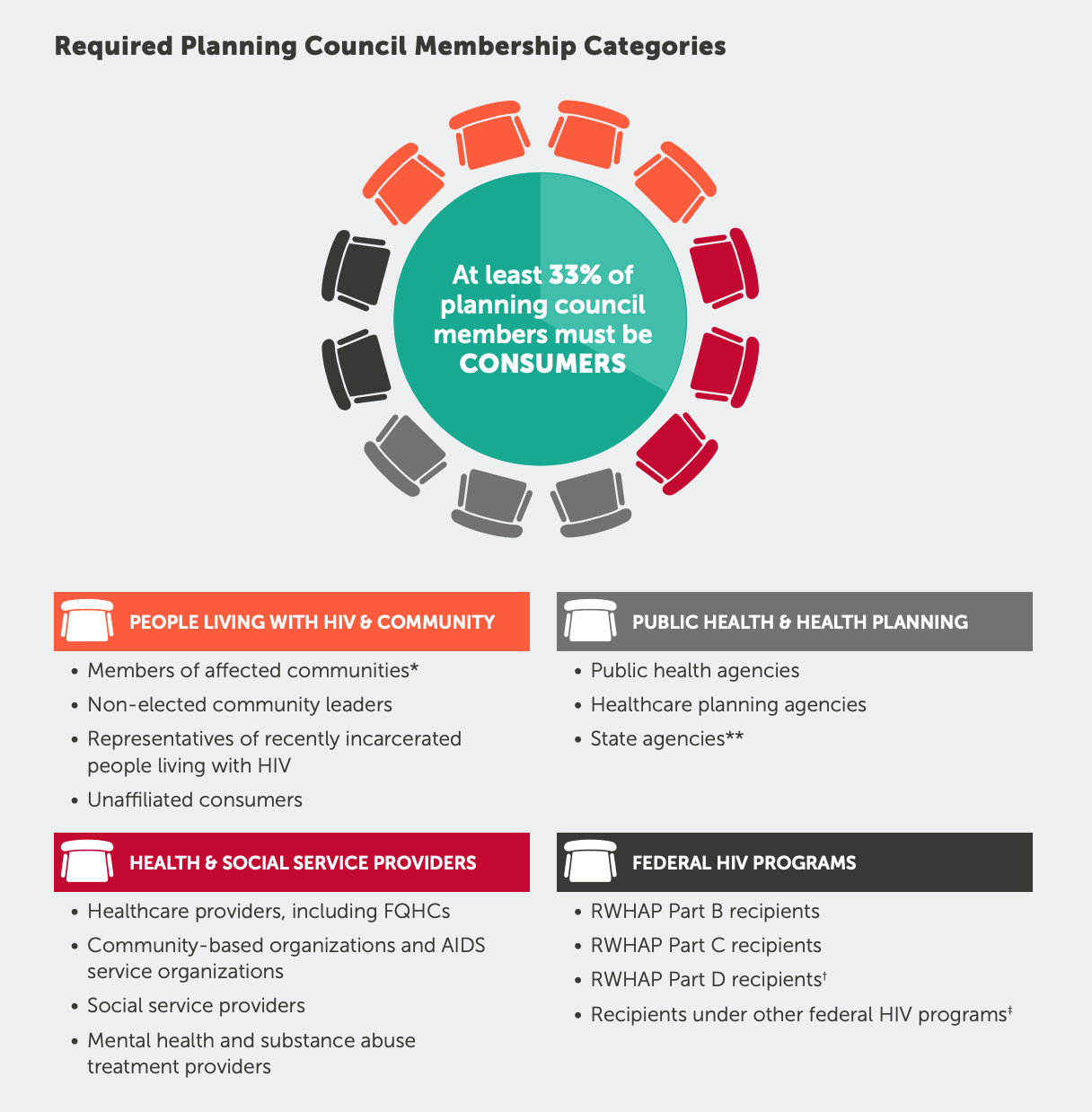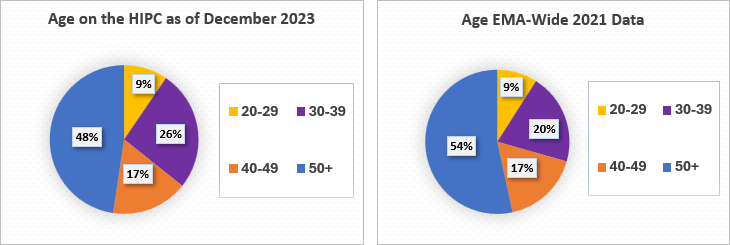About HIPC
HIPC is different from OHP (Office of HIV Planning). OHP consists of hired staff that supports HIPC and its duties. If you are looking for “About OHP,” click here.
HIPC does not provide direct services. If you are having an issue with or need access to services, please call the Client Services Unit at (215) 985-2437.
Our Mission
The HIV Integrated Planning Council (HIPC) works to ensure that all people living with HIV (PLWH) have fair, equitable, and appropriate access to all services within the Philadelphia EMA. HIPC focuses on the continuous improvement in service system standards and functions to maximize the quality of life for PLWH.
We do so by:
- Promoting diversity and inclusivity through listening to individual needs;
- Maximizing meaningful involvement of PLWH on the Council through active recruitment and by providing an additional, designated space for PLWH to meet with each other;
- Diminishing barriers to care and promoting dignity by following client-centered approaches;
- Ensuring that PLWH and service providers work together and have open discussions around all levels of design, delivery, and evaluation of services;
- Upholding and advocating for the autonomy and agency of PLWH.
What is HIPC?
“Almost three quarters of people living with HIV in the U.S. live in RWHAP Part A-funded areas. These areas are called eligible metropolitan areas (EMAs) or transitional grant areas (TGAs)” (From the RWHAP Planning Council Primer). The Philadelphia HIV Integrated Planning Council, also known as HIPC, represents the Philadelphia EMA, which is most easily understood as the Philadelphia County and the surrounding, impacted counties in both New Jersey and Pennsylvania.
HIPC works with the Recipient (the Division of HIV Health, also known as DHH) to allocate funds and create directives for the Ryan White HIV/AIDS Program (RWHAP) Part A service categories. Ryan White Part A is a payer of last resort and helps those with HIV who are uninsured, underinsured, or uninsurable. Ryan White Part A covers service categories ranging from Outpatient/Ambulatory Health Services and Medical Case Management to Housing and Food Bank services. Click here to learn more about the service categories that RWHAP Part A supports.
HIPC consists of volunteers. Within HIPC (the full Planning Council), there are also six subcommittees. As a member of the Planning Council, individuals are also required to join at least one of the six subcommittees.
Why does HIPC exist?
The HIV Integrated Planning Body (HIPC) integrated in 2017. Before integration, there were two groups: one group focused on prevention, and the other focused on care. The two groups integrated to create HIPC, since Prevention and Care were often interconnected and equally important within the HIV Care Continuum.
HIPC members are community volunteers that either provide or receive Ryan White HIV services. Prevention related services are funded by the CDC (Centers for Disease Control and Prevention) while HRSA (Health Resources and Services Administration) is responsible for administering RWHAP services throughout the country. This means that HIPC has both contractual requirements (with CDC) and those that are federally mandated (from the HRSA). In other words, there are certain requirements about what HIPC should look like from both the CDC and HRSA.
What are the HIPC requirements?
As was stated above, there are certain requirements about what HIPC should look like. HIPC volunteers should be reflective of the HIV epidemic as well as meet contractual requirements and what is federally mandated of the group.
For HIPC as a whole, based on their bylaws, the group should be between 35 and 55 members and meet the following legislative requirements:

On top of this, it is vital that overall HIPC membership meet the requirements of reflectiveness— having characteristics that reflect the local epidemic in such areas as race, ethnicity, gender, and age.
Why is this important? Reflectiveness of the HIV epidemic and involvement of providers and consumers within HIPC is exactly what makes HIPC unique and effective. HIPC members use their own personal and provider experience/information to provide a special type of expertise. Every HIPC member is an expert in their own way and provides valuable information. Matching the reflectiveness of the HIV Epidemic within the Planning Council helps to achieve needed representation within decision-making. The idea for reflectiveness ultimately comes down to this: communities and consumers should be able to decide how services can best serve them and their communities.
*All information on HIPC membership requirements has been gathered from the RWHAP Planning Council Primer).
Is HIPC meeting its requirements?
Below, you will find a chart with HIPC membership as of December 2023 broken down by race/ethnicity, gender, and age as compared to the share of the HIV epidemic within the Philadelphia EMA in 2021:

—

—

Based on these charts, it is clear that in general, HIPC is in need of more members to reach its goal of 55 total members. On top of this, in order to be reflective of the epidemic, HIPC is most looking to increase members who are:
- Non-Hispanic Black
- From PA and NJ counties
- Transgender
- Male
- PLWH (People Living with HIV)
- Youth/young adults
As you can see, the Planning Council is close to its goals for reflectiveness, but is always in need of more members. If you think you are a good fit for the Planning Council, please consider applying!
What are HIPC's main responsibilities?
HIPC’s three main responsibilities include (1) developing and monitoring the 5-year Philadelphia HIV Integrated Prevention and Care Plan and (2) allocating funds and creating directives for RWHAP Part A services through the yearly Allocations Process and (3) determining the service Priorities based on the documented needs of the community. HIPC meets as a full council and within subcommittees to create needs assessments, set priorities, invite presenters, and much, much more to help inform their decisions.
As previously mentioned, HIPC works with the Recipient of RWHAP Part A funds for the Philadelphia EMA. What does this mean and who is the Recipient? As the short answer, RWHAP Part A funds typically go to the mayor who then chooses a main agency to manage the grant. In Philadelphia’s case, the recipient that works with the Planning Council is DHH (the Division of HIV Health). DHH is part of the Philadelphia Department of Public Health and specializes in overseeing HIV service organizations.
Therefore, the Planning Council is responsible for making decisions about service priorities and resource allocation of RWHAP Part A funds and relaying these decisions to DHH for implementation.
You can find out more about HIPC’s roles & responsibilities as well as how HIPC/subcommittee meetings operate by clicking here to access OHP’s training page. This page contains video recordings of OHP’s virtual trainings, breaking down the HIPC process and highlighting important skill sets for participation.
How does the HIPC application process work?
You can apply to HIPC by clicking here.
First, an open nominations panel--consisting of HIPC members--reviews all applications. Applicants are reviewed twice a year in a fall and spring open nominations process. All applicants’ information is kept confidential, and all revealing information is redacted from the applications before review. The open nominations panel reviews the applications to recommend them for appointment by the mayor.
Afterwards, the recommended applications go to the mayor’s office for appointment to the Planning Council. The mayor must approve and appoint all applications before the applicants can be officially considered as part of the Planning Council. Applicants who have not yet been appointed by the mayor can still attend HIPC meetings (as the meetings are public), but cannot vote until official appointment.
Please note: Included in the application is also a Certificate of Tax Clearance for the applicant to fill out. This form is required by the mayor’s office and must be filled out in order to be appointed to the Planning Council.
